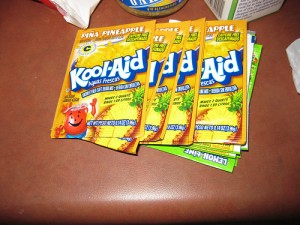 Crowdfunding giant Kickstarter hit a rough patch lately with some project misses (and some all-out fails), but one thing they’ve done right? Crisis communications, a notoriously complicated area for brands and businesses—and one that can, in many instances, determine overall brand image and sometimes even the ultimate success of a company. Continue reading
Crowdfunding giant Kickstarter hit a rough patch lately with some project misses (and some all-out fails), but one thing they’ve done right? Crisis communications, a notoriously complicated area for brands and businesses—and one that can, in many instances, determine overall brand image and sometimes even the ultimate success of a company. Continue reading
Agency Outreach Gone Wrong: And How to Avoid It
 Work as part of a PR or ad agency team doing outreach to bloggers or influencers on behalf of your client? If so, there are some easy steps to follow to make sure your outreach yields good results.
Work as part of a PR or ad agency team doing outreach to bloggers or influencers on behalf of your client? If so, there are some easy steps to follow to make sure your outreach yields good results.
And before I begin, I’ll say that this post was prompted because I got a very nice email today from someone reaching out on behalf of their client, a very big one, asking about opportunities to connect when we write on topics specific to their client. I’m being intentionally vague here because I believe this person isn’t incompetent, they just don’t know any better. And that? That’s the PR agency’s fault. Continue reading
Knowing Your Audience: How PR Agencies Need to be Careful Choosing Customers

Recently, in the town of Skegness in England, there was uproar when Italian ‘premium’ beer brand Peroni was accused of snobbery for not allowing its product to be sold in a hotel in the town. The hotel’s manager claimed consultants working on behalf of the brand stated the town didn’t ‘fit the brand’, and implied there was a snobbery issue at heart.
This isn’t the first time that a brand has been accused of trying to dictate who its audience should be. An executive for Cristal champagne hinted that he did not approve of this endorsement of its premium product after it was embraced by Jay-Z and a number of other rappers. This resulted in the champagne being boycotted by the rapper, and no doubt many of his fans. Continue reading
Get Geoff Livingston’s Welcome to the Fifth Estate Free
Auto-tweets, Kawasaki and Takedowns: The Ugly Side of Social
The Monday afternoon bombings at the Boston Marathon in Massachusetts sent shockwaves across the world and social networks. As has been the case since Facebook, Twitter and blogs became staples in our world, social media was the place to get immediate information. While not always accurate, it was integral in the wake of this tragedy.
When events such as this occur, it is essential that we make sure our clients aren’t pushing product or seemingly “cheery” type posts during a tragedy of this manner. The world isn’t going to stop, but we as community managers and public relations pros need to be sensitive. This wasn’t the case with well-known social media personality Guy Kawasaki. Continue reading
2013: The Year that Social Media Will Run out of Kool-Aid

Anyone who operates within the social media space knows all too well “the bandwagon effect” that new platforms and pundits’ prognostications can have on the entire ecosystem. A new tool is released, a different approach to a standard procedure is introduced, predictions abound of what direction the industry is headed in, and advice on how to maximize your social media efforts are as common as spilled popcorn on a movie theatre floor. Those that blindly follow advice without critical examination or thinking of the nuances of their own communities are often referred to as “drinking the Kool-Aid.” Continue reading
Top 5 Tips for Adapting a Relationship Marketing Model
 In the age of consumer marketing, which focused on advertising benefits and features of a product, this automobile ad would have been strategically placed in a men’s magazine. There is enough text in this ad for a short story and a message being pushed to the male reader (and his ego). With a consumer marketing mindset, the brand’s arching goal was to strategically pinpoint the people who would need, use, and ultimately buy their product. For an individual, consumer marketing meant being talked at, not with. Continue reading
In the age of consumer marketing, which focused on advertising benefits and features of a product, this automobile ad would have been strategically placed in a men’s magazine. There is enough text in this ad for a short story and a message being pushed to the male reader (and his ego). With a consumer marketing mindset, the brand’s arching goal was to strategically pinpoint the people who would need, use, and ultimately buy their product. For an individual, consumer marketing meant being talked at, not with. Continue reading
Writing Workshop: Before You Hit Publish
 While my Kansas City friends were stuck with more snow, I spent the end of last week soaking up the sun and fun in the Gaylord Biodome at Blissdom (where is that sarcasm font when you need it)?
While my Kansas City friends were stuck with more snow, I spent the end of last week soaking up the sun and fun in the Gaylord Biodome at Blissdom (where is that sarcasm font when you need it)?
At V3, we work with agencies and brands and do a lot of blogger and influencer outreach. My recent workshop: Writing for the Web: What, Why and How to Kick Butt At It is intended to help bloggers master the art of not only writing for the web, but also understanding how to deliver great results for the brands and agencies they work with.
Content marketing is the number one strategic marketing focus for brands and agencies, so when bloggers understand the basics of content marketing, they can better position themselves for relationships that are mutually beneficial. And agencies and brands, we’re all over that.
But writing for the web and effective content marketing takes skill. It’s not as easy as writing a blog post. And the work doesn’t stop when you’ve written the post. The distribution channels you develop and relationships you’ve cultivated over the years can have a huge impact on the success (read that: reach and impact) of your content. Equally as important is tracking your results and reporting back to your brand or agency partners–which is delivering the ultimate value as a content partner.
But distribution and reporting are things I’ll cover in a subsequent post. Back to writing. Here are the bare bones, must-do things you should do before you hit that “publish” button:
Before You Hit “Publish”
The Basics
- Your headline is key. Make sure it’s compelling, captures attention and is clear on the value your post delivers. Cute but unclear won’t cute it.
- Make sure your post is 300 words minimum and no more than 700.
- Images are important. Sometimes an image is what makes me read your post, so be sure and include one.
- Your first paragraph is very important. Make sure it delivers the key message of the post and that it’s short and compelling.
- Cite your sources and make sure that any claims made are linked to clear sources.
SEO 101
- Your headline must be 60 characters or less.
- Your first paragraph must be strong and include the keyword or keyword phrase from your title.
- Make sure you’ve included a link in your first sentence or first paragraph that connects to a related piece from the blog on which you’re publishing.
- Include 2-5 additional links within the body of the post that connect to relevant material on relevant external sites, as well as the site on which you’re publishing. All links within the body of the post should not be to your site or to the site that your post is appearing on.
- Make sure your links use text phrases 2-5 words long and describe where the link leads (i.e. use “writing for bloggers” vs. “click here”).
- Use bolded subheads in your post to help readability.
- Use keywords wisely in your subheadings.
- All images have captions, alt text and titles relevant to the post topic.
Content
- Read the post aloud to proofread before publishing.
- Use contractions. This will help your writing sound conversational.
- Ask yourself if you’re using needless jargon and if so, ditch it.
- Make 100% certain that your post delivers what the headline claims, otherwise, you’ll annoy your readers.
- Don’t ramble. This is where reading aloud will help you. If your content isn’t on topic, get rid of it.
- Provide valuable action steps instead of vague, empty statements.
- Finish with a strong call-to-action at the end.
- Edit, edit and edit again.
And there you have it–your pre-publish writing checklist. Bookmark it, print it out, tattoo it on your arm–whatever you do, make sure you keep these tips in mind as you’re creating content for the web. My wish is for you to develop fantastic, long-lasting relationships with great brands and agencies. And hopefully these tips will help you write content that knocks their socks off.
Image: Courtney Dirks via Compfight cc
Follow the Path of Least Resistance
Hallelujah! You know someone who knows someone in the very media organization where you’re trying to get coverage. That second someone may be the very person you think is most likely to be interested in the something you’re pushing.
Quite often the first someone may be working within your own organisation, perhaps in a different section to you. Continue reading
From Mail to Maker’s Mark: A Scale for Assessing Flack-Reporter Relationships

Every PR pro has been in the scenario: the team is gathered in a conference room. The topic of media comes up, and various names are bandied about. Then the boss growls, “who has a relationship with that reporter?” The implication is clear: in a business of connections, the person doing the pitching should have some sort of tie to the writer/editor/blogger in question.
Invariably, someone pipes up, claiming they have a relationship with the reporter in question. But the word “relationship” is fuzzy, Continue reading
 No Tricks
No Tricks